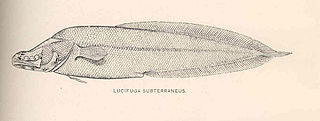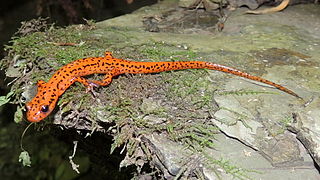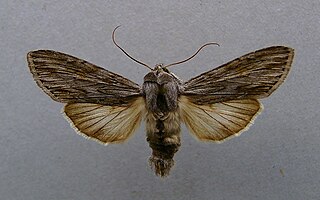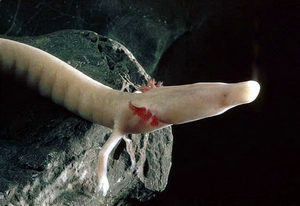
Brook salamanders are a genus, Eurycea, of salamanders native to North America.

The viviparous brotulas form a family, the Bythitidae, of ophidiiform fishes. They are known as viviparous brotulas as they generally bear live young, although there are indications that some species do not. They are generally infrequently seen, somewhat tadpole-like in overall shape and mostly about 5–10 cm (2–4 in) in length, but some species grow far larger and may surpass 60 cm (2 ft).
Lucifuga simile is a species of cavefish in the family Bythitidae. It is endemic to Cuba. It is a demersal species found in freshwater and brackish water. It can reach a length of 8.8 centimetres (3.5 in).

Lucifuga is a genus of viviparous brotulas. Most of the species are native to caves and sinkholes in Cuba and the Bahamas; L. inopinata from deep water off the Galápagos Islands is the only exception. The four species rated by the IUCN are all considered vulnerable. The largest species in the genus reaches about 15 cm (5.9 in) in length.
The New Providence cusk-eel, also known as the Bahama cavefish, is a species of cavefish in the family Bythitidae. It is endemic to the Bahamas, where it has been reported from a small number of marine blue holes, inland caverns and chasms. It is the only known cusk eel species that can occur in surface waters; all others exclusively live in the deep parts of the ocean, or in underwater caves. It was first described in 1970.

Lucifuga subterranea, or the Cuban cusk-eel, is a species of cavefish in the family Bythitidae. It is endemic to Cuba. Within the caves, sinkholes and crevices in which it occurs it is common, it feeds on cirolanid isopods.
Lucifuga teresinarum is a species of cavefish in the family Bythitidae. It is endemic to Cuba.
Epipsocidae is an insect family of Psocodea belonging to the suborder Psocomorpha, that includes, among others, the genera Bertkauia, Epipsocus, Epipsocopsis, Goja, and the New Guinean endemic Dicropsocus. It includes 16 genera with more than 140 species. The only European species in the family is the apterous Bertkauia lucifuga. Like the other members of the infraorder Epipsocetae, they have a labrum with two sclerotized ridges. Epipsocids are barklice found primarily in tropical regions, and one of their distinguishing characteristics is the hairy ventral surface of the forewing.

The spotted-tail salamander, also known as a "cave salamander", is a species of brook salamander.

Balea sarsii is a species of air-breathing land snail, a terrestrial pulmonate gastropod mollusk in the family Clausiliidae.

Cucullia lucifuga is a species of moth of the family Noctuidae. It is found in north, central and southern Europe east to Japan. It is also present in Tibet and Armenia.

A cave salamander is a type of salamander that primarily or exclusively inhabits caves, a group that includes several species. Some of these animals have developed special, even extreme, adaptations to their subterranean environments. Some species have only rudimentary eyes. Others lack pigmentation, rendering them a pale yellowish or pinkish color.
Ectopsocus axillaris is a species of Psocoptera from the Ectopsocidae family that can be found in Great Britain and Ireland. The species are brownish-black coloured and is similar to Bertkauia lucifuga.

Gnaphosa lucifuga is a ground spider species with Palearctic distribution.
Troglohyphantes lucifuga is a species of cave spider of the family Linyphiidae. Its distribution is European: France, Italy, Switzerland.
Bertkauia is a genus of insects in the family Epipsocidae. There are at least 2 described species in Bertkauia.
Bertkauia crosbyana is a species of elliptical barklouse in the family Epipsocidae. It is found in Central America and North America.
Caloplaca lucifuga is a species of fungus belonging to the family Teloschistaceae.
Solitaria is a fungal genus in the family Teloschistaceae. It contains a single species, the corticolous (bark-dwelling), crustose lichen Solitaria chrysophthalma.









